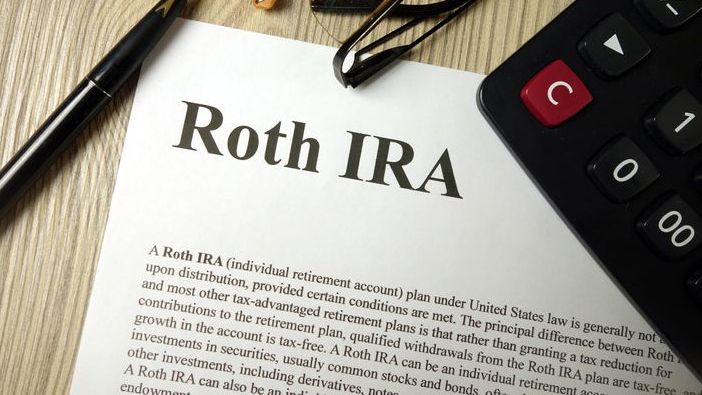
Should you switch from pre-tax IRA contributions to Roth contributions?
Imagine that you’re steadily contributing to a traditional IRA. This provides you with an annual tax deduction. However, contributing to a tax-deferred account comes at the cost of having to pay taxes on all of the money you withdraw in retirement. Switching to a Roth IRA would reverse this dynamic, leaving you with less capital after paying taxes upfront in exchange for tax-free growth and tax-free withdrawals.
As with all tax questions, the right decision will depend on your circumstances. The answer here may be to speak with a professional to determine what you should do. But in the meantime, here are a few things to think about. (And if you need help finding a financial advisor, consider using this free matching tool to connect with one.)
Roth IRA vs. Traditional IRA
A traditional IRA is what’s called a pre-tax or tax-deferred account. You don’t pay taxes on the money until you withdraw it. However, you’ll owe income tax on the full balance – your original investment plus any gains.
A Roth IRA is an after-tax account. You don’t get a tax deduction for your contributions but you typically pay no taxes on the money when you withdraw it. That means your money grows tax-free. A bonus of Roth IRAs is that they aren’t subject to required minimum distributions (RMDs), which can increase your tax bill in retirement. (Remember, a financial advisor can potentially help you navigate RMDs and build a plan for limiting your tax liability in retirement.)
Both types of IRAs have the same annual contribution limits. In tax year 2024, you can contribute up to $7,000 to your IRAs, plus an additional $1,000 if you’re 50 or older. For tax year 2023, the IRS limits contributions to $6,500, plus the extra $1,000 if you’re 50 or older.
Opportunity Cost: A Key Issue

So if you’re 60, does switching to Roth contributions make sense?
Opportunity cost is an important part of this. If you invest using a Roth IRA, the money you pay in immediate taxes is capital that you could have otherwise invested. This gives traditional IRAs potential growth that can offset the Roth IRA’s tax advantages.
For example, say that you invest $500 per month in a new Roth IRA. Over 10 years, at the S&P 500’s average 10% rate of return, this account would grow to roughly $102,000.
But those contributions will effectively require $600 per month: the $500 you invest plus the $100 you pay in taxes on that money (assuming a 20% effective tax rate). With a traditional IRA, you don’t pay those taxes on the money upfront, allowing you to invest the additional capital. This would give you $600 per month, which if invested in the same account would grow to about $123,000 (under the same assumptions). However, after paying taxes, you’d likely end up with less in this example than you would have if you contributed to a Roth IRA.
“Transitioning to Roth contributions at 60 presents a complex decision. Starting a new portfolio late in life raises questions about the trade-off between potential growth and withdrawal time horizon,” said Dutch Mendenhall, CEO of RAD Diversified.
Among other issues to consider, Mendenhall recommends thinking about what kind of retirement you want to have. What benefits do you see in switching and how will you balance those long-term gains against your short-term goals? And how does this factor into your retirement and estate planning?
(But if you need an expert opinion on which type of IRA you should have, consider speaking with a fiduciary financial advisor today.)
When Will You Need the Withdrawals?
Roth IRAs, and conversions to Roth IRAs (more below), are subject to what’s called the five-year rule. With this rule, you need to wait at least five years before making a withdrawal, or be subject to a 10% penalty plus taxes. So if your planning to start using a new Roth IRA before age 65, this strategy has its limitations. However, waiting will also give you better opportunity for long-term account growth.
When Will You Have A Higher Tax Rate?
If you expect to have a higher income in retirement than you do today, contributing to a Roth account may be the wiser strategy. In that case, your tax bracket in retirement will likely be higher than it is today, so you save more by paying your taxes at today’s lower rates.
A traditional IRA can make more sense, on the other hand, if your situation is reversed. If your income today is higher than it will be in retirement, you may save more by taking the tax deduction today and paying income taxes on the money later when you’re in a lower tax bracket.
This makes Roth IRA contributions difficult for someone approaching 60. At this point in your career, you likely have hit your peak earnings and peak tax bracket. If you switch to Roth IRA contributions, there’s a chance that you will pay more in taxes today as opposed to in a few years. (And if you need help making decisions like this one, consider speaking with a financial advisor.)
Roth Contributions vs. Conversions

Finally, it’s worth considering whether you should do a full Roth conversion instead of simply switching to Roth contributions.
With a Roth conversion, you would move your existing $1 million IRA portfolio into a tax-free Roth IRA portfolio. This is good for growth because $1 million grows faster than $8,000 (the IRA contribution limit for savers 50 and older in 2024). You will also have your money in a single, after-tax portfolio that won’t be subject to RMDs.
Just be aware that you will need to pay taxes on that entire $1 million all at once in the year that you make the conversion. That’s a lot of income tax all in one go and, if you do have that cash on hand, you might simply be better off putting it in a separate portfolio to grow on its own.
You can also consider breaking the $1 million into a series of Roth conversions in the coming years to avoid converting the full amount in a single year. This may help you keep your income from surging into the top 37% tax bracket. (And if you need more help evaluating whether a Roth conversion is right for you, consider working with a financial advisor.)
Bottom Line
Whether you should switch to Roth IRA contributions depends on your present and planned tax status. Approaching age 60, the odds are that you will be better off continuing to contribute to your IRA, but the answer is entirely situational. You’ll want to evaluate your unique financial situation and potentially enlist the help of an expert to determine whether switching is a suitable strategy for you.
IRA Management Tips
- While we talk about traditional IRAs vs. Roth IRAs, there are several different types of individual retirement accounts that you may be eligible to have. Also, keep the annual contribution limits in mind, since these limits can change from year to year.
- A financial advisor can help you build a comprehensive retirement plan. Finding a financial advisor doesn’t have to be hard. SmartAsset’s free tool matches you with up to three vetted financial advisors who serve your area, and you can have a free introductory call with your advisor matches to decide which one you feel is right for you. If you’re ready to find an advisor who can help you achieve your financial goals, get started now.
Photo credit: ©iStock.com/Space_Cat, ©iStock.com/RapidEye, ©iStock.com/Piotrekswat